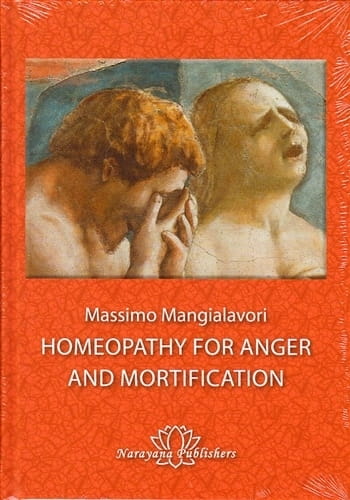Complaints due to anger and mortification - an everyday issue in homeopathic practice. Mortification can be expressed as a feeling of shame, wounded honour, or loss of self-confidence. The famous Italian homeopath Massimo Mangialavori describes in this work the most important homeopathic remedies that have proved particularly useful for these problems in his practice. He highlights especially the less well-known and often forgotten remedies. He presents impressive cases of Ipecacuanha, Senega officinalis, and Magnetis polus australis, differentiating these in detail from other remedies such as Ferrum magneticum, Antimonium tartaricum, Chelidonium, Ignatia, the Bromine, and Chlorine salts, Paris quadrifolia, Chamomilla, Staphisagria as well as the Scrophulariaceae and Liliaceae.
Massimo Mangialavori is known for his graphic remedy descriptions in which he brings out the essential nuances of homeopathic remedies in a concise and vivid way. This handy booklet is a great opportunity to get to know the working methods of Massimo Mangialavori in this important area.
Reprinted with the permission of The Alliance of Registered Homeopaths. From the Journal 'Homeopathy in Practice', Autumn 2012 edition. Reviewed by Jemima Kallas.
This lovely little book is a joy to handle and a pleasure to read. The pleasure begins from the first glance: size A5, it fits into the hand when it lies open, a beautiful hardback with a picture of a devastated Adam and Eve sobbing after their expulsion from Paradise. So, we know what we are going to get: shame, guilt, longing, regret, loss of self-confidence, despair - otherwise known as 'ailments from anger or mortification'.
From the second paragraph of the introduction, it is clear that this wise book rests on broad scholarship:
The word 'mortification' comes from the Latin mortificus meaning 'causing death (mors-mortis, death + facere, make, produce)'.
Mangialavori then sets the scene by describing how anxiety and mortification play out in practice, and now it is the voice of experience grounded in materia medica that speaks, an approach that comes from both heart and intellect. These pages consist of a series of short, clear paragraphs that differentiate the range of emotional states that tend to underlie insecurity and suggests words for the pains this could cover. Reading them is to deepen one's understanding as a prescriber and open one's soul as a human - and that's before we are three pages into the book.
There are 87 more pages to come. These explore anger and mortification through three unexpected remedies: Ipecacuanha, Senega officinalis and Magnetis polus australis, each with a detailed case and follow-up; and then a further eight remedies plus the Halogens, each given a page or two, concluding with several pages of 'Mangialavori's Repertory Additions'. For Magnetis polus australis, for example, the additions include 'ailments from anger, vexation', bold (153); and 'dreams, buildings, demolished' (2).
The subtle case-taking is a pleasure in itself. Almost from the outset, the remedy is not always a surprise, but how come? How does Mangialavori do it? Slow down your reading to catch him gently probing, and then guiding your understanding with running commentaries. But why does he devote the opening case in such a short book on anger and mortification to Ipecac"? And devote the first four pages of the case to vomiting? Be patient. The consultation slides deeper and suddenly, and not quite out of nowhere, the subject is exploding with fury and calling his father 'a shit'.
Each case is opened out with short commentaries to guide student and experienced homeopath alike, and underpinned with 'impressions of the case', repertorisation, follow-up, remedy differentiation, and an exploration of the remedy that resolved the case.
There is nothing tired about the more rapid reviews of materia medica. A common remedy such as Ignatia is given a new angle by standing next to Chelidonium and Staphysagria alongside Paris quadrifolia.
The Repertory changes are not so much additions as adjustments: for example, Staph, 'ailments from admonition' (italics - Radar grades this bold underlined), or 'dignity' (italics - Radar gives low type); 'rectum, haemorrhoids, painful, very', has been upgraded from low type to bold. Some changes or what appear to be additions may be because Mangialavori has based his entries on another repertory. On the other hand, the point of his exploration is that he is putting forward alternatives for huge portfolio rubrics such as the 'ailments from' rubrics associated with anger and mortification by offering a much more nuanced understanding of the emotions that underlie, and he does this in his introduction, through his cases, and in the groupings that appear in the appendix repertory. This book is a valuable addition to anyone's materia medica.

